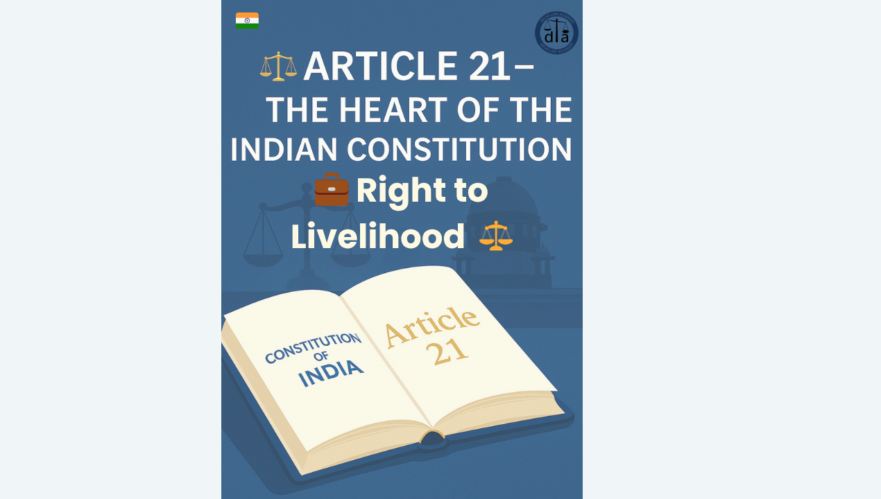
💼 Right to Livelihood | Article 21 of the Indian Constitution
The Right to Livelihood is a vital component of the Right to Life under Article 21 of the Indian Constitution.
It ensures that every individual has the means to earn a living with dignity, as the ability to sustain oneself is inseparable from the right to life itself.
📜 Constitutional Basis
While the Constitution does not explicitly mention the Right to Livelihood, it has been interpreted by the judiciary as an integral part of Article 21.
A life of dignity is impossible without access to work, income, and basic economic security.
“The right to life includes the right to livelihood because no person can live without the means of living.”
— Olga Tellis v. Bombay Municipal Corporation (1985)
⚖️ Landmark Judgments on Right to Livelihood
- 🏙️ Olga Tellis v. Bombay Municipal Corporation (1985) – The Supreme Court held that the eviction of pavement dwellers without rehabilitation violated their Right to Livelihood under Article 21.
- 🌾 State of Maharashtra v. Chandrabhan Tale (1983) – The Court ruled that employment is essential to maintain life and cannot be arbitrarily taken away without just procedure.
- 👷♀️ Delhi Development Horticulture Employees’ Union v. Delhi Administration (1992) – The Court highlighted the importance of employment schemes to protect the poor from starvation and deprivation.
- 🏭 Maneka Gandhi v. Union of India (1978) – The Court expanded the scope of Article 21, emphasizing that the right to life means a life of dignity and security, not mere animal existence.
Through these rulings, the judiciary has linked the right to work, livelihood, and dignity as inseparable elements of a meaningful life.
🏛️ State Responsibility and Welfare Measures
The State has a constitutional duty to promote conditions that secure employment and protect livelihoods.
Article 39(a) of the Directive Principles directs the State to ensure adequate means of livelihood for all citizens.
- 💪 Implementation of job creation programs for rural and urban poor.
- 🌾 Introduction of social security measures like MGNREGA for daily wage earners.
- 🏘️ Protection of informal workers and small traders from exploitation.
- ⚖️ Ensuring fair wages, safe working conditions, and non-discrimination.
These welfare initiatives translate the constitutional vision of economic justice into reality.
📘 Relationship with Directive Principles of State Policy
The Right to Livelihood is supported by several Directive Principles in Part IV of the Constitution:
- 📜 Article 39(a): Adequate means of livelihood for all citizens.
- 👩🌾 Article 41: Right to work, education, and public assistance in certain cases.
- 🏭 Article 43: Promotion of cottage industries and workers’ participation in management.
These provisions, though not enforceable by law, serve as guiding principles for social and economic development.
👥 Protection of Informal and Vulnerable Workers
A significant portion of India’s population depends on informal employment.
The courts and legislature have emphasized extending protection to street vendors, laborers, domestic workers, and agricultural laborers through welfare schemes and legal safeguards.
The Street Vendors (Protection of Livelihood and Regulation of Street Vending) Act, 2014 is one such example that protects workers’ rights to earn a living with dignity.
🌏 Conclusion
The Right to Livelihood ensures that no person is deprived of the means to live a life of dignity.
Recognized as part of Article 21, it upholds economic and social justice as essential components of the right to life.
True freedom exists only when every individual has the opportunity to work, sustain themselves, and live with self-respect.
📘 Free Study Material for Law Students!
Download our FREE study material prepared by Delhi Law Academy’s expert faculty.
💬 Frequently Asked Questions on Right to Livelihood
It is part of the Right to Life under Article 21, as life without income or employment is meaningless.
Laws like the Street Vendors Act, 2014 safeguard their rights to work and earn a living with dignity.
Without livelihood, other Fundamental Rights lose their practical significance.
Contact us
📍 Delhi Law Academy – Jaipur Branch
6C, Tower 2, Coaching Hub, Pratap Nagar, Jaipur – 302033
📞 Phone:
+91 9911916552
+91 8447285606
✉️ Email:
contactus@delhilawacademy.com

